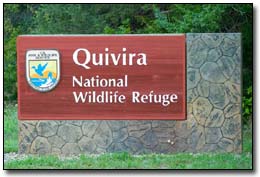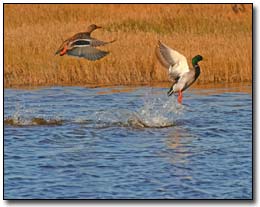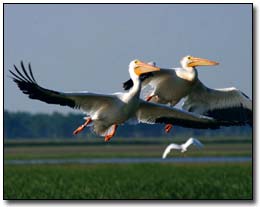|
Quivira National Wildlife Refuge lays right in the heart of the United States
Central Flyway for migratory birds. It also is the crown jewel in the gently
undulating sand hills of the sand prairie of central and south central Kansas.
 Hundreds of varieties of birds call this place home if only for a brief period while
migrating through. Spring and fall bring huge concentrations of migratory birds
including hundreds of thousands of waterfowl and Sand Hill Cranes. Most of the
native Whooping Cranes from Wood Buffalo National Park in Canada also stop by in
staggered flights and may spend a few days if the prevailing winds are not
favorable. Eagles, both Bald and a few Golden spend a good amount of time here in
the winter, hunting injured waterfowl as well as keeping a close eye on the prairie
dog population. Whitetail Deer, including some really nice bucks, abound on the
refuge, as well as turkey, coyotes, bobcats, beaver, mink, all sorts of smaller
critters, insects and some spring and late summer prairie wildflowers that are just
spectacular.
Hundreds of varieties of birds call this place home if only for a brief period while
migrating through. Spring and fall bring huge concentrations of migratory birds
including hundreds of thousands of waterfowl and Sand Hill Cranes. Most of the
native Whooping Cranes from Wood Buffalo National Park in Canada also stop by in
staggered flights and may spend a few days if the prevailing winds are not
favorable. Eagles, both Bald and a few Golden spend a good amount of time here in
the winter, hunting injured waterfowl as well as keeping a close eye on the prairie
dog population. Whitetail Deer, including some really nice bucks, abound on the
refuge, as well as turkey, coyotes, bobcats, beaver, mink, all sorts of smaller
critters, insects and some spring and late summer prairie wildflowers that are just
spectacular.
QNWR encompasses some 27,000+ acres, in which there is a lot to see and do for
everyone. Bob Gress, director of the Great Plains Nature Center in Wichita, KS, and
 co-author/photographer for his book "Faces of the Great Plains", traveled all over
the Midwest and mountain states making photos for his book and noted that Quivira is
tops for wildlife viewing and photography. The refuge is well managed and it shows
when you drive through.
co-author/photographer for his book "Faces of the Great Plains", traveled all over
the Midwest and mountain states making photos for his book and noted that Quivira is
tops for wildlife viewing and photography. The refuge is well managed and it shows
when you drive through.
Rattlesnake Creek feeds the refuge from the west-southwest and well as some natural
artesian type springs in places where the groundwater just bubbles up into the
marsh. In drought years, Quivira can get very dry, but there's always just enough
water to support the many birds. All seasons of the year are good times in which to
visit and observe the wildlife and flat prairie landscape and scenery. Dawn and
dusk normally present spectacular skies.
There is a healthy population of reptiles in QNWR and prudent care should be
exercised in the warm weather months for avoiding/not disturbing the native Western
Massasauga Rattlesnakes. The larger ones are normally docile and somewhat
lethargic, but the little ones can be a bit aggressive. Just wear pants and boots
if you plan on plunging into the tall thick grass off of the roadways and mowed
trails. Wearing shorts and sandals in the thick stuff would be pure foolishness!
The refuge is rather narrow (approximately 2-2.5 miles wide) east and west, by
rather long (17-18 miles long) north and south. A main arterial gravel road cuts
 through it north and south and allows visitors to see much of the refuge via
automobile touring. There are a few trails to walk and many other places that are
closed to vehicle traffic are open to visitors walking in. Again, if walking in
areas, be prepared by dressing appropriately and carry a daypack or fanny pack with
any necessities, drinking water, etc.
Plan on utilizing your photo and optics gear to its full potential here and in
addition to the big telephoto and zoom lenses, don't forget some wider ones for some
of the breathtaking skyscape shots at sunrise and sunset. Dust from the roads can
be a problem as well as unpredictable prairie weather so come prepared along those
lines too.
through it north and south and allows visitors to see much of the refuge via
automobile touring. There are a few trails to walk and many other places that are
closed to vehicle traffic are open to visitors walking in. Again, if walking in
areas, be prepared by dressing appropriately and carry a daypack or fanny pack with
any necessities, drinking water, etc.
Plan on utilizing your photo and optics gear to its full potential here and in
addition to the big telephoto and zoom lenses, don't forget some wider ones for some
of the breathtaking skyscape shots at sunrise and sunset. Dust from the roads can
be a problem as well as unpredictable prairie weather so come prepared along those
lines too.
To reach Quivira National Wildlife Refuge; from Hutchinson, KS, take US Hi-way 50
west to the tiny town of Zenith and head straight north 8 miles to the entrance and
headquarters (which is open weekdays), from Great Bend, KS, go south on US 281 to
4th St. Rd. and turn east for 14 miles.
Jerry Segraves lives in Stafford, KS just 13 miles from Quivira National Wildlife Refuge and spends much of his free time there chasing critters around, trying to get a few photos, harassing the help, and
generally being a nuisance all over the place.
| 
